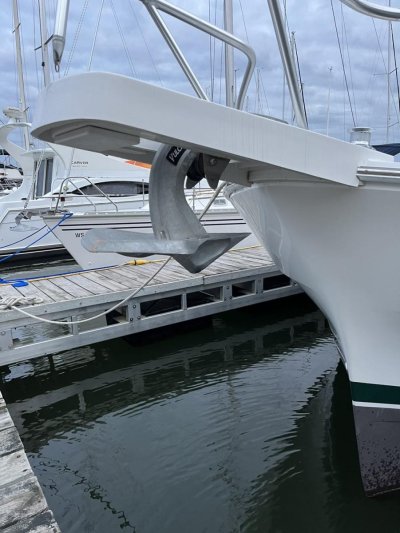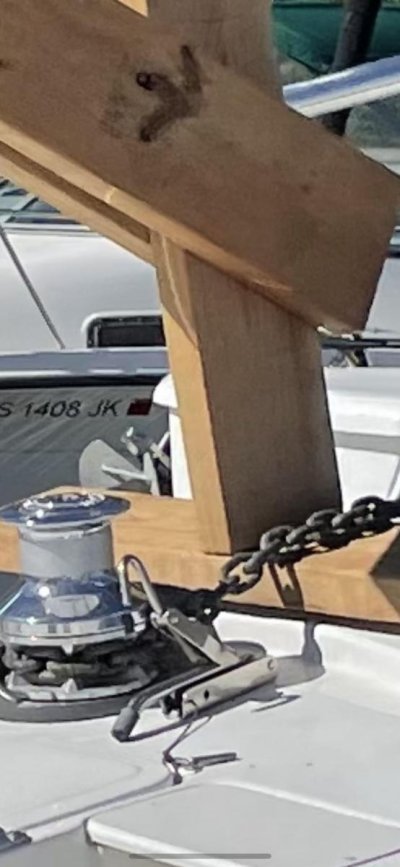mncruiser
Senior Member
I'm having a specific problem, hoping for some guidance here.
My 2001 Mainship 390 came with a Rocna Vulcan 44lb. anchor when I bought it 3 years ago. I was excited, after reading here for a number of years how it was a good anchor.
I boat in Lake Superior, specifically the Apostle Islands. I'd say 100% of my anchoring is in sand, I generally am 20 feet deep or less when I anchor, in mostly calm conditions.
My rode is all chain, well almost....the last 30 feet or so are line. I've never deployed it past the chain.
My problem is, I can't get this anchor to easily set, ever. It is to the point that I am ready to buy a different anchor. My dock walk last weekend and talking with friends, 90% of what people use around me are Danforth/Fortress types split equally with a plow type anchor.
Last time we anchored, it took me 5 times to get it to set, in completely calm conditions, good deep sand bottom. I tried every combination. Backing while dropping. Drop, then back. Less scope. Tons of scope. Again and again. My swivel swivels, there is nothing bent or bound.
Once it is set, I have no problems, and Bob (former owner) left me a nice bridle that is slick as snot.
Is this anchor more difficult to use? I've got no other explanation than either I really suck at it....or it sucks! Ha!
I do notice there is a heck of a keel on the bottom of it. Does this make it harder to set?
Looking for ideas. I'm inclined to go for a plow type as my primary roller, I have a backup smaller Danforth anchor I may upgrade as well for a backup.
Or could it be me? I am suspicious, I have seen very few of my anchor around me. But I know a bunch of you whom I respect a lot have this exact anchor....so I'm pausing.
Here is a pic of the miserable thing ;-)
Any ideas?
Thanks
My 2001 Mainship 390 came with a Rocna Vulcan 44lb. anchor when I bought it 3 years ago. I was excited, after reading here for a number of years how it was a good anchor.
I boat in Lake Superior, specifically the Apostle Islands. I'd say 100% of my anchoring is in sand, I generally am 20 feet deep or less when I anchor, in mostly calm conditions.
My rode is all chain, well almost....the last 30 feet or so are line. I've never deployed it past the chain.
My problem is, I can't get this anchor to easily set, ever. It is to the point that I am ready to buy a different anchor. My dock walk last weekend and talking with friends, 90% of what people use around me are Danforth/Fortress types split equally with a plow type anchor.
Last time we anchored, it took me 5 times to get it to set, in completely calm conditions, good deep sand bottom. I tried every combination. Backing while dropping. Drop, then back. Less scope. Tons of scope. Again and again. My swivel swivels, there is nothing bent or bound.
Once it is set, I have no problems, and Bob (former owner) left me a nice bridle that is slick as snot.
Is this anchor more difficult to use? I've got no other explanation than either I really suck at it....or it sucks! Ha!
I do notice there is a heck of a keel on the bottom of it. Does this make it harder to set?
Looking for ideas. I'm inclined to go for a plow type as my primary roller, I have a backup smaller Danforth anchor I may upgrade as well for a backup.
Or could it be me? I am suspicious, I have seen very few of my anchor around me. But I know a bunch of you whom I respect a lot have this exact anchor....so I'm pausing.
Here is a pic of the miserable thing ;-)

Any ideas?
Thanks
Last edited:

